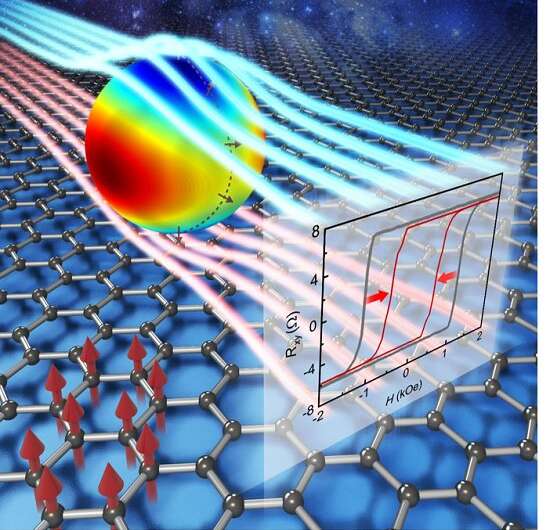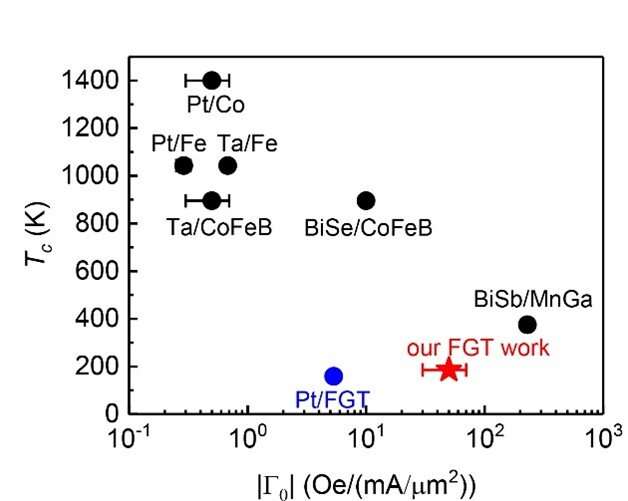Energy-efficient magnetic RAM: A new building block for spintronic technologies

Researchers at Pohang University of Science and Technology (POSTECH) and Seoul National University in South Korea have demonstrated a new way to enhance the energy efficiency of a non-volatile magnetic memory device called SOT-MRAM. Published in Advanced Materials, this finding opens up a new window of exciting opportunities for future energy-efficient magnetic memories based on spintronics.
In modern computers, the random access memory (RAM) is used to store information. The SOT-MRAM (spin-orbit torque magnetic RAM) is one of the leading candidates for the next-generation memory technologies that aim to surpass the performance of various existing RAMs. The SOT-MRAM may operate faster than the fastest existing RAM (SRAM) and maintain information even after the electric energy supply is powered off whereas all fast RAMs existing today lose information as soon as the energy supply is powered off. The present level of the SOT-MRAM technology falls short of being satisfactory, however, due to its high energy demand; it requires large energy supply (or large current) to write information. Lowering the energy demand and enhancing the energy efficiency is an outstanding problem for the SOT-MRAM.
In the SOT-MRAM, magnetization directions of tiny magnets store information and writing amounts to change the magnetization directions to desired directions. The magnetization direction change is achieved by a special physics phenomenon called SOT that modifies the magnetization direction when a current is applied. To enhance the energy efficiency, soft magnets are ideal material choice for the tiny magnets since their magnetization directions can be easily alterned by a small current. Soft magnets are bad choice for the safe storage of information since their magnetization direction may be altered even when not intended—due to thermal noise or other noise. For this reason, most attempts to build the SOT-MRAM adopt hard magnets, because they magnetize very strongly and their magnetization direction is not easily altered by noise. But this material choice inevitably makes the energy efficiency of the SOT-MRAM poor.

A joint research team led by Professor Hyun-Woo Lee in the Department of Physics at POSTECH and Professor Je-Geun Park in the Department of Physics at Seoul National University (former associate director of the Center for Correlated Electron Systems within the Institute for Basic Science in Korea), demonstrated a way to enhance the energy efficiency without sacrificing the demand for safe storage. They reported that ultrathin iron germanium telluride (Fe3GeTe2, FGT)—a ferromagnetic material with special geometrical symmetry and quantum properties—switches from a hard magnet to a soft magnet when a small current is applied. Thus when information writing is not intended, the material remains a hard magnet, which is good for the safe storage, and only when writing is intended, the material switches to a soft magnet, allowing for enhanced energy efficiency.
"Intriguing properties of layered materials never cease to amaze me: the current through FGT induces a highly unusual type of spin-orbit torque (SOT), which modifies the energy profile of this material to switch it from a hard magnet to a soft magnet. This is in clear contrast to SOT produced by other materials, which may change the magnetization direction but cannot switch a hard magnet to a soft magnet," explains Professor Lee.
Experiments by Professor Park's group revealed that this FGT-based magnetic memory device is highly energy-efficient. In particular, the measured magnitude of SOT per applied current density is two orders of magnitude larger than the values reported previously for other candidate materials for the SOT-MRAM.

"Controlling magnetic states with a small current is essential for the next-generation of energy-efficient devices. These will be able to store greater amounts of data and enable faster data access than today's electronic memories, while consuming less energy," notes Dr. Kaixuan Zhang who is a team leader in Professor Park's group, interested in studying the application of correlated quantum physics in spintronic devices.
"Our findings open up a fascinating avenue of electrical modulation and spintronic applications using 2-D layered magnetic materials," closed Professor Lee.
More information: Kaixuan Zhang et al, Gigantic Current Control of Coercive Field and Magnetic Memory Based on Nanometer‐Thin Ferromagnetic van der Waals Fe3GeTe2, Advanced Materials (2020). DOI: 10.1002/adma.202004110
Journal information: Advanced Materials
Provided by Pohang University of Science & Technology (POSTECH)




















